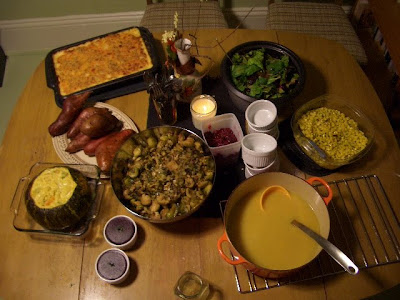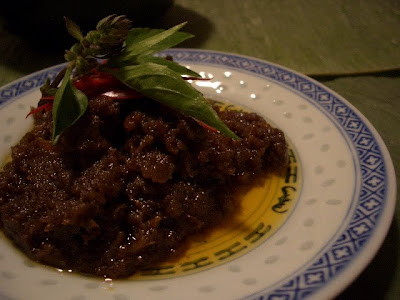

Long story short, I spent this last month orchestrating the big move back to The South, capital S. There was packing and selling and more packing and driving to be done—and then all of a sudden it was Christmas and I was in North Carolina with my entire extended family and tomorrow is the last day of 2009.



Excuses, excuses.
But now I am back on the couch in my parents’ house, new dog in tow, beginning Job Search 2.0, reminiscing about this

Earlier this month I made a quick trip to Palmetto, GA, for an interview/work day at Serenbe Farms. I dug up sunchokes (aka Jerusalem artichokes), plucked radishes and got super muddy. It was exhilarating spending all day outside, touching and digging and sniffing out delicious food in its most primitive form.
The farm is part of a unique little community being built about an hour south of Atlanta. It’s planned and suburban, yes, but it’s also 100% focused on sustainability, organic farming and alternative ways of interacting with our environment. All of the homes are built to maximize energy retention and minimize carbon footprints. The streets curve in such a way that it takes longer to drive than to walk. The farm and the two restaurants have this amazing exchange program—the farm sells the restaurant excess produce and the restaurants give back their waste in the form of compost—it’s a complete cycle. Most of the residents participate in the CSA program, and the town farmer’s market brings organic foodies from all over each week. The farm even does educational programs with elementary schools in the area, and as far as I’m concerned, the more kids who want to dig in the dirt, the better. The residents have a bit more money than most, but I honestly think that all of this is a good thing. If all of us with the resources to contribute to improving the food system were as conscious about it as those in Serenbe, change would come much faster.
Perhaps one of the best parts of this little jaunt was the schwag I brought home from the interview, like these little guys

Mix together these babies with some spinach (or more seasonal salad greens, preferably dug up from your garden), kohlrabi and a citrusy dressing and you’ve got a salad that’ll brighten up even the snowiest of December days (I’m talking to you, Portland).

Also on my plate is that vegetable tart made with pureed sunchokes, sautéed Swiss chard and onions, and a sprinkling of Parmesan. The onions, olive oil, flour and cheese were from the regular grocery, but almost everything else came from my cold and muddy hands.

Talk about local.
Radish and Kohlrabi Salad with Citrusy Dressing
1 head kohlrabi, cut into a thin julienne using a mandoline or very sharp knife
6-8 French radishes, thinly sliced into transparent rounds
Seasonal salad greens, enough for four people
¼ teaspoon each of grapefruit, lime, lemon and orange zest
about ¼ cup mixed citrus juice (I used lemon, lime and orange)
pinch of brown sugar
olive oil
sea salt
freshly ground black pepper
Assemble radishes and kohlrabi on top of greens. Season with salt and pepper. Mix the zests with the juice and sugar. Slowly whisk in the oil to taste (I like about a 50-50 ratio, but most people find that a bit too acidic). Add salt and pepper. Lightly dress the salad right before serving.
Sunchoke and Chard Tart
Olive Oil Tart Crust (I used Clotilde’s, from Chocolate and Zucchini, with a 50-25-25 mix of all-purpose flour, whole wheat flour and cornmeal)
olive oil
1 pound (I think … Just fill up a cookie sheet…) sunchokes, peeled and cut into 2-inch long chunks
3 cloves garlic, peeled
¼-½ cup stock of your choice
2 bunches Swiss, red, or rainbow chard, stems and leaves separated
2 sweet onions
¼ cup dry white wine
½ cup freshly grated Parmesan cheese
kosher salt
Preheat the oven to 400 degrees. Prepare the tart crust and chill in the fridge for about an hour.
Place the peeled sunchokes on a baking sheet with the garlic cloves. Season with salt and drizzle with a little bit of olive oil (just enough to keep them moist and to prevent sticking). Roast until fork tender (I honestly can’t remember how long I cooked them, but I think it was probably 20-30 minutes). Take out of the oven and let cool until you’re able to touch them without screaming in pain.
Meanwhile, prick the crust all over with a fork, line with aluminum foil and fill with dried beans. Cook for about 7-10 minutes, remove the foil and beans, and cook 7-10 minutes more until ever so golden brown. Let cool until you’re done with everything else.
While the sunchokes are cooling and the crust is baking, chop up the chard stems into 1-inch long pieces and the leaves into bite-sized pieces. Slice the onion into a thin julienne. Heat about one tablespoon of olive oil over medium-ish heat in your biggest and best saucepan. Once it shimmers, add the onion and the chard stems. Saute until they soften and then add the wine. Cook until most of the wine evaporates. Season with salt, and add the chard leaves. Saute until the greens soften and then remove from the heat.
At this point, your sunchokes should be cool enough to handle. Place them and the garlic into the bowl of a food processor. Drizzle in a bit more olive oil and ¼ cup of stock. Puree until smooth, adding more stock and/or oil until smooth. Add about 2/3 of the cheese, pulse to combine and taste for seasoning. Add salt if necessary.
Pour the sunchoke puree into the tart crust. Spread with a spatula so that it evenly covers the tart. Carefully spread the chard and onion mixture on top, again trying to make sure that it is even. Sprinkle the rest of the cheese on top and bake (still at 400 degrees) for about 15 minutes or so, or until everything is hot and bubbly and the cheese is melted and browned. Let cool for 10-15 minutes so that it doesn’t explode everywhere. Serve with the radish and kohlrabi salad to all of your locavorious foodie friends.







































